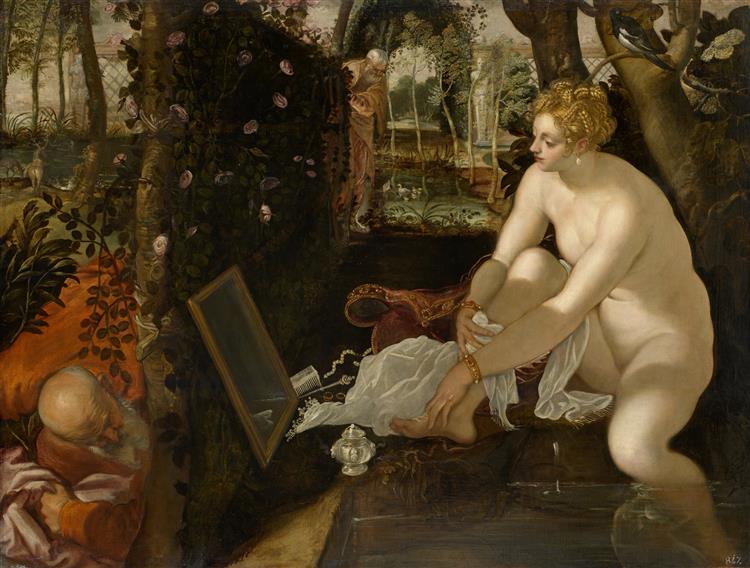
This picture was chosen because it represents chapter 3 in John Berger's "Ways of Seeing" which mentions the woman in the mirror, and her vanity, and reflects on the positionality of a woman and her gaze, as well as the male gaze. Berger poses many concepts vital to Art History that prove valuable to a feminist understanding of art. According to Berger, "men survey women before treating them" (46). This is the male gaze. So therefore "women watch themselves being looked at" (47). Tintoretto's Suzannah and the Elders represents this relationship effectively. The woman looks into the mirror, a man looks at the woman from behind the mirror and a man in the distance watches her nude figure. The woman may not be aware of the man's presence, as she is fixated on the mirror. This picture is a representation not of a woman's assertion of power against the male gaze, but of a more participatory act that places the woman as one who is vain.
"You painted a naked woman because you enjoyed looking at her, you put a mirror in her hand and you called the painting Vanity thus morally condemning the woman whose nakedness you had depicted for your own pleasure." (53)
These depictions of women that range from the Renaissance to the 1800s in "Vanity paintings" serve as a voice for the male painter's treatment and understanding of womanhood. Nudity signifies not only the individuality of oneself, but one's ability to become an object in the eyes of others. Tintoretto's painting represents the genre of nude vanity paintings which represent one way in which the system of images in art systematically oppresses women. This framework relates to Laura Mulvey's understanding of spectatorship in art and the male gaze. When applying Berger's ideas to a modern lens, film is inevitably a landing place. According to Mulvey, women act as accessories in film and as objects to be stared at by the viewer as well as people in the film. This is exactly akin to the painting Suzannah and the Elders, which, as discussed, depicts men gazing upon an unknowing woman who gazes upon herself, transferring the gaze to the viewer and asking them to objectify, or not, the subject. For a female viewer, this painting reeks of the feeling of being watched, though her gazing in the mirror doesn't seem vain. Compare this painting to Faith Ringgold's Woman Looking in the Mirror and the difference in depiction becomes obvious. Ringgold's subject is clothed, and gazes assertively in the mirror, staring back, almost, the viewer as if to ask, "can you objectify me?" Ringgold's painting is a subversion of the notions of the vanity painting, while Tintoretto's work exemplifies the gaze in more ways than one.
Works Cited
https://www.thecollector.com/what-can-we-learn-from-john-berger-ways-of-seeing/
https://monoskop.org/images/9/9e/Berger_John_Ways_of_Seeing.pdf